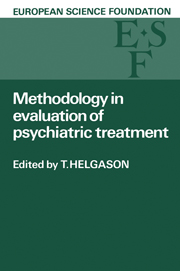 Methodology in Evaluation of Psychiatric Treatment
Methodology in Evaluation of Psychiatric Treatment Book contents
- Frontmatter
- Contents
- Participants
- Foreword
- Preface
- INTRODUCTION
- I METHODS OF CLASSIFICATION
- II EVALUATION CRITERIA
- III RATING METHODS IN EVALUATION OF TREATMENT
- TheAMP Rating Methods
- The Comprehensive Psychopathological Rating Scale (CPRS)
- The Use of Rating Scales for Affective Disorders
- Self-Rating Scales in the Evaluation of Psychiatric Treatment
- Methods for Measuring Social Adjustment
- IV OTHER QUANTITATIVE METHODS OFEVALUATION OF TREATMENT
- V ETHICALAND PRACTICAL PROBLEMS
- Index
TheAMP Rating Methods
from III - RATING METHODS IN EVALUATION OF TREATMENT
- Frontmatter
- Contents
- Participants
- Foreword
- Preface
- INTRODUCTION
- I METHODS OF CLASSIFICATION
- II EVALUATION CRITERIA
- III RATING METHODS IN EVALUATION OF TREATMENT
- TheAMP Rating Methods
- The Comprehensive Psychopathological Rating Scale (CPRS)
- The Use of Rating Scales for Affective Disorders
- Self-Rating Scales in the Evaluation of Psychiatric Treatment
- Methods for Measuring Social Adjustment
- IV OTHER QUANTITATIVE METHODS OFEVALUATION OF TREATMENT
- V ETHICALAND PRACTICAL PROBLEMS
- Index
Summary
Development of the AMP system
In 1965 the Association for Methodology and Documentation in Psychiatry (AMP) was founded by several German-speaking psychiatrists from Germany, Switzerland and Austria (Angst et 0/1969). It was the aim of these psychiatrists to develop together a system for the documentation of psychopathological and somatic symptoms which are characteristic for the description of psychiatric patients. In 1971 the first edition of the AMP manual was published (Scharfetter 1971), followed by the second edition in 1972 (Scharfetter 1972). This manual contained a detailed description of every item, especially of the psychopathological symptoms. In 1979 the third, revised edition of the manual was published and the name of the system was changed to AMDP (AMDP 1979). One of the reasons for this change was to prevent further confusion with cyclic AMP. Equally important was the wish to emphasize that the new version of the system has been the result of many years of methodological work and many intense discussions.
Today the new edition of the AMDP system has been used in several hospitals for the routine documentation of psychiatric patients, especially in Berlin and Munich. Methodological examination of the new version for example, of the inter-rater reliability or the construction of subscales is not finished. For the moment it is, therefore, impossible to give a detailed synopsis of the AMDP system. In this situation I will concentrate on the following subjects: 1. Training of raters; 2. Instructions for raters; 3. Development of AMP short forms, especially two second-order scales, which will most probably survive the change from AMP to AMDP; 4. Comparison between AMDP system and other well-known rating scales.
During the last AMDP meeting in 1980 it was reported that the system has been translated into 11languages (Baumann & Faehndrich 1981). One of these translations has given me a lot of help in preparing this paper: ‘The North American Adaptation of the AMDP System’ by William Guy and Thomas Ban (in preparation).
Description of the AMDP assessment documents
AMDP consists of five integrated parts, each printed on a single sheet of paper: 1. Anamnesis - Demographic data; 2. Anamnesis - Life events; 3. Anamnesis - Historical data; 4. Psychopathological symptoms; 5. Somatic signs. This paper concentrates on parts 4 and 5, the rating of psychopathological and somatic symptoms.
- Type
- Chapter
- Information
- Methodology in Evaluation of Psychiatric TreatmentProceedings of a Workshop Held in Vienna 10–13 June 1981, pp. 151 - 162Publisher: Cambridge University PressPrint publication year: 1983


